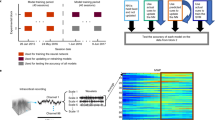Abstract
New architectures for Brain-Machine Interface communication and control use mixture models for expanding rehabilitation capabilities of disabled patients. Here we present and test a dynamic data-driven (BMI) Brain-Machine Interface architecture that relies on multiple pairs of forward-inverse models to predict, control, and learn the trajectories of a robotic arm in a real-time closed-loop system. A method of window-RLS was used to compute the forward-inverse model pairs in real-time and a model switching mechanism based on reinforcement learning was used to test the ability to map neural activity to elementary behaviors. The architectures were tested with in vivo data and implemented using remote computing resources.
Chapter PDF
Similar content being viewed by others
References
Kawato, M., Wolpert, D.M.: Multiple paired forward inverse models for motor control. Neural Networks 11, 1317–1329 (1998)
Fortes, J., Figueiredo, R., Hermer-Vazquez, L., Principe, J., Sanchez, J.: A New Architecture for Deriving Dynamic Brain-Machine Interfaces. In: ICCS-DDDAS (2006)
Erhan Oztop, D.W., Kawato, M.: Mental state inference using visual control parameters. Cognitive Brain Research 22, 129–151 (2004)
Carmena, J., et al.: Learning to control a brain–machine interface for reaching and grasping by primates. PLoS Biology 1, 1–16 (2003)
Doya, K.: What are the computations of the cerebellum, the basal ganglia and the cerebral cortex? Neural Networks 12, 961–974 (1999)
Nicolelis, M., et al.: Reconstructing the engram: simultaneous, multisite, many single neuron recordings. Neuron 18, 529–537 (1997)
Bower, G.: Theories of Learning, 5th edn. Prentice-Hall, Inc., Englewood Cliffs (1981)
Sutton, R., Barto, A.: Reinforcement learning: an introduction. MIT Press, Cambridge (1998)
DiGiovanna, J., Sanchez, J., Principe, J.: Improved Linear BMI Systems via Population Averaging. In: IEEE Conf. Eng. in Medicine and Biology Society (2006)
Whishaw, I.: The behavior of the laboratory rat. Oxford University Press, Oxford (2005)
Haykin, S.: Adaptive Filter Theory. Prentice-Hall, Englewood Cliffs (2002)
Golub, G.H., Van Loan, C.F.: Matrix computations. Johns Hopkins, Baltimore (1989)
Liu, H., He, Z.: A sliding-exponential window rls adaptive filtering algorithm: properties and applications. Signal Process 45(3), 357–368 (1995)
Sakai, H., Nakaoka, H.: A fast sliding window QRD-RLS algorithm. Signal Process 78(3), 309–319 (1999)
Author information
Authors and Affiliations
Editor information
Rights and permissions
Copyright information
© 2007 Springer Berlin Heidelberg
About this paper
Cite this paper
DiGiovanna, J. et al. (2007). Towards Real-Time Distributed Signal Modeling for Brain-Machine Interfaces. In: Shi, Y., van Albada, G.D., Dongarra, J., Sloot, P.M.A. (eds) Computational Science – ICCS 2007. ICCS 2007. Lecture Notes in Computer Science, vol 4487. Springer, Berlin, Heidelberg. https://doi.org/10.1007/978-3-540-72584-8_127
Download citation
DOI: https://doi.org/10.1007/978-3-540-72584-8_127
Publisher Name: Springer, Berlin, Heidelberg
Print ISBN: 978-3-540-72583-1
Online ISBN: 978-3-540-72584-8
eBook Packages: Computer ScienceComputer Science (R0)





